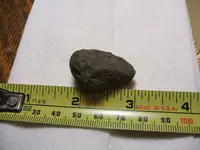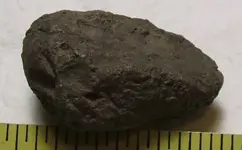There are several things to look for in a meteorite.
Attraction to a magnet
Meteorites will easily stick to a magnet. Use a good quality magnet to test your specimen.
Weight
Meteorites are dense, they will feel heavier than ordinary Earth rocks.
Fusion crust
Recently fallen meteorites will exhibit a "fusion crust." This is a thin black rind, sometimes shiny, sometimes matte black, which is acquired during burning in the atmosphere. A freshly fallen stone meteorite will look much like a charcoal briquette! Even stone meteorites that have been on the Earth for a long time usually retain some fusion crust and almost always appear much darker than ordinary rocks.
Surface features
Meteorites, especially irons, often acquire "regmaglypts" (thumbprints) caused when their surface melts during flight. Stone meteorites sometimes display regmaglypts too, but they are not as well defined as in irons. Meteorites, particularly irons, may also show angular features such as points and ridges, and also flowlines which are caused by melting. Many of the suspected meteor-wrongs we receive are common terrestrial volcanic rocks. Volcanic rocks (along with other types) often contain small, deep holes, as if they had been repeatedly punctured with a needle. These holes are called vesicles and are caused by gas escaping when lava cools. Meteorites do not have vesicles . If you rock has lots of small pin-prick holes, it is not a meteorite.
Metallic flakes
Nearly all stone meteorites contain small, bright metallic flakes. These are tiny pieces of extra-terrestrial iron and nickel. You can usually see them after slicing off a small piece, or removing a corner with a bench grinder. I recommend that you do not cut up your suspected meteorite, or otherwise damage its appearance. A meteorite with a beautiful or interesting shape will be worth less to collectors if its end has been hacked off.
Chondrules
Small, colorful, grain-like spheres which occur in most stone meteorites, hence the name of these stone meteorites — chondrites. Chondrites are the most common type of meteorite. Chondrules are not found in earth rocks.
Rust or patina
Meteorites which have been on the Earth for a long time will likely start to rust, or — in dry desert environments — acquire a "patina" caused by oxidation. The natural patina of irons is often yellow/ochre, red, or orange.
Hope this helps.
Seth






